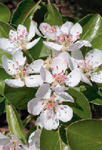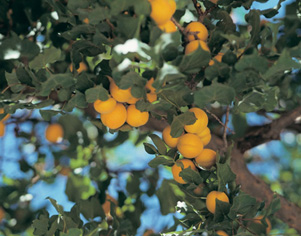

Apple blossoms of Malus pumila, growing near Mancelona, Michigan.
ASK ANYONE ABOUT THE GARDEN of Eden and the apple will usually come up. Yet it is not mentioned in the first book of the Bible. In fact, except for Joel 1:12 and Proverbs 25:11, the apple, tappooakh in Hebrew (cognate with modern Arabic toophah), is mentioned only in the Song of Solomon (2:3b, 5a, 7:8a, 8:5b).
Because the Hebrew word implies a fruit that is fragrant, it could be that tappooakh includes other fruits such as the apricot (Prunus armeniaca). Apricots can survive less rainfall and hotter temperatures than apples (Juniper and Mabberley 2006), and they are fragrant, evidence that the apple tree of the Bible could, in fact, be apricot. Could the verse “A word fitly spoken is like apples of gold in pictures of silver” (Proverbs 25:11, KJV) be an allusion to the apricot tree in fruit? The word for apple is tappooakh in this verse. Some cultivars of apricot have leaves with a silvery undersurface, lending credence to apricot being intended in this verse.
The apple, Malus pumila (formerly Pyrus malus), was introduced to the Middle East long ago (Zohary and Hopf 2000) and remains a popular fruit in the region. However, cultivation is limited to areas with adequate water and moderate temperatures.
How did the apple become transported in legend to the Garden of Eden? Foster (1899) traces the development of the apple in ancient times and how apple became grafted in a literary sense to the Garden of Eden.

Apricot in flower in March, at an Assyrian village near Tel Tamir, Syria.

Apricot tree laden with fruit in June, near Deir Attaya, Syria.
Somehow the idea of Eve offering Adam an apricot seems heterodox because of the enduring legend, without textual support, of the apple of temptation in the garden. However, the apricot—no mean fruit itself in terms of desirability—may be the “apple” of Eden.